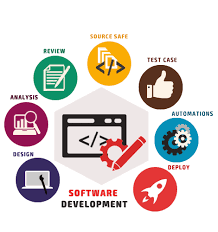Maximizing Success Through Expert Software Development Consulting
The Importance of Software Development Consulting
Software development consulting plays a crucial role in helping businesses navigate the complex world of technology. Whether you are a startup looking to build a new application or an established company seeking to modernize your existing software systems, consulting services can provide invaluable expertise and guidance.
Benefits of Software Development Consulting
**Expertise**: Software development consultants are experts in their field with extensive knowledge of programming languages, development methodologies, and industry best practices. They can offer insights and recommendations that help you make informed decisions about your software projects.
**Efficiency**: By leveraging the experience of software development consultants, you can streamline your development process and avoid common pitfalls that may lead to delays or cost overruns. Consultants can help you set realistic goals, establish timelines, and optimize workflows for maximum efficiency.
**Innovation**: Consultants bring fresh perspectives and innovative ideas to the table. They can introduce you to new technologies, tools, and approaches that may enhance the functionality and performance of your software solutions.
How Software Development Consulting Works
When you engage a software development consultant, the process typically involves:
- Initial assessment: Consultants will assess your current software infrastructure, understand your business goals, and identify areas for improvement.
- Planning: Together with your team, consultants will create a customized development plan that outlines project scope, deliverables, timelines, and resources required.
- Implementation: Consultants will work closely with your developers to execute the plan, provide guidance on coding standards, architecture design, testing procedures, and more.
- Evaluation: After implementation, consultants will evaluate the success of the project based on predefined metrics and make recommendations for further enhancements or optimizations.
Choosing the Right Software Development Consultant
When selecting a software development consultant for your project, consider the following factors:
- Experience: Look for consultants with a proven track record of successful projects in your industry.
- Communication: Ensure that consultants have excellent communication skills and can effectively collaborate with your internal teams.
- Cultural fit: Choose consultants who align with your company culture and values to foster a productive working relationship.
In Conclusion
Software development consulting is an investment in the future success of your business. By partnering with experienced consultants, you can unlock new opportunities for growth, innovation, and efficiency in your software projects. Take advantage of their expertise to stay ahead in today’s competitive digital landscape.
6 Essential Tips for Successful Software Development Consulting
- Understand the client’s needs and requirements clearly.
- Communicate effectively with the client throughout the project.
- Provide regular updates on the progress of the development.
- Ensure that the software meets quality standards and is well-tested.
- Offer training and support to the client for using the software.
- Maintain a good relationship with the client for future collaborations.
Understand the client’s needs and requirements clearly.
Understanding the client’s needs and requirements clearly is a fundamental tip in software development consulting. By taking the time to thoroughly grasp what the client wants to achieve with their software project, consultants can tailor their solutions to meet those specific goals. Clear communication and active listening are key in this process, ensuring that all parties are on the same page and working towards a common objective. This approach not only helps in delivering a successful software solution but also fosters trust and collaboration between the consultant and the client.
Communicate effectively with the client throughout the project.
Effective communication with the client throughout a software development consulting project is essential for success. By maintaining open and transparent communication channels, consultants can ensure that the client’s requirements are clearly understood, expectations are managed, and any issues or changes are addressed promptly. Regular updates, progress reports, and feedback sessions help build trust and collaboration between the consulting team and the client, leading to a smoother project delivery and ultimately a more satisfied client.
Provide regular updates on the progress of the development.
It is essential to provide regular updates on the progress of software development projects during consulting engagements. Keeping stakeholders informed about the status of the development helps maintain transparency, manage expectations, and identify any potential issues early on. Regular updates also foster collaboration and ensure that all parties involved are aligned with the project goals and timelines. By communicating consistently throughout the development process, software development consultants can build trust with their clients and demonstrate their commitment to delivering successful outcomes.
Ensure that the software meets quality standards and is well-tested.
To ensure the success of your software development consulting project, it is crucial to prioritize quality standards and thorough testing. By ensuring that the software meets established quality benchmarks and undergoes rigorous testing processes, you can identify and address potential issues early on, leading to a more reliable and efficient final product. Quality assurance measures not only enhance the user experience but also instill confidence in the software’s performance and functionality, ultimately contributing to the overall success of the project.
Offer training and support to the client for using the software.
One essential tip in software development consulting is to provide training and ongoing support to the client for effectively using the software. By offering comprehensive training sessions and accessible support resources, clients can better understand the functionalities of the software, maximize its potential, and address any issues that may arise. This proactive approach not only enhances user experience but also builds trust and long-term relationships with clients, ensuring their continued satisfaction with the software solution.
Maintain a good relationship with the client for future collaborations.
Maintaining a good relationship with the client is a crucial tip in software development consulting as it paves the way for future collaborations and long-term success. By fostering open communication, understanding the client’s needs, and delivering high-quality solutions, consultants can build trust and credibility. A strong client relationship not only enhances the current project but also opens doors for potential future engagements, referrals, and partnerships. Investing in building a positive rapport with clients can lead to mutually beneficial outcomes and sustained business growth in the dynamic field of software development consulting.












